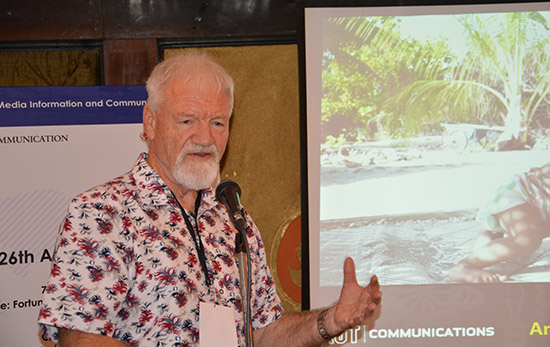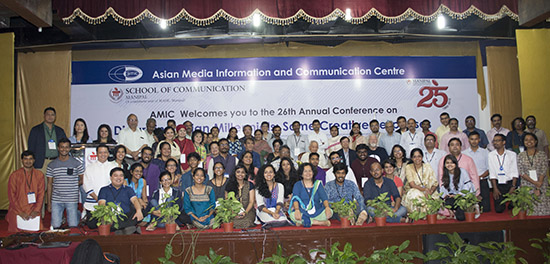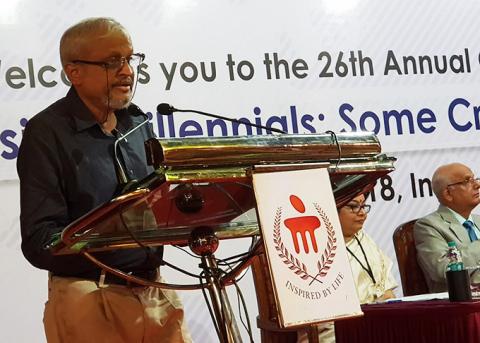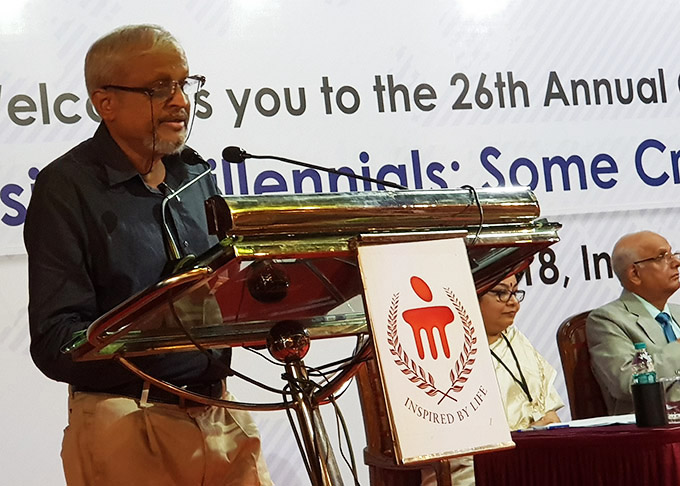
The digital age and the power and challenges of the Millennials as presented by keynote speaker Professor B P Sanjay, pro vice-chancellor of the University of Hyderabad, at the AMIC2018 conference at Manipal, Karnataka, India, on 7-9 June 2018.
The theme of the 26th AMIC (Asian Media Information and Communication) annual conference focuses on disturbing Asian millennials in the context of digital communication ecosystem. Disturbance or disruption is not considered negative but an opportunity to build on. The breadth and scope of this address cannot be pan-Asian given the limitations of time. It is assumed that diverse and plural perspectives can be expected from the distinguished registrants to the conference. With a focus on India and comparable features in a few other contexts, this address will focus on implications of the changes for the Millennials. That Asia has a significant share of world millennials speaks volumes about the manner in which new media has caught their imagination in China and India. China’s adaptive context is more discussed in comparative literature than India.
The euphoric underpinnings of the digital era into which the Asian region and its sub-variants, the Asia-Pacific, the ASEAN and South Asia have leaped into is reminiscent of many such parallels in the past, both colonial and post-colonial that have highlighted the techno-centric dimension. Panaceas for development, redeeming and reinforcing democratic traditions, empowerment and participation have been the paradigms of such celebration. Several academic discourses have contested simplistic replacement notions of replacement of old media when a new medium emerges. Notwithstanding several critiques of the key structural variables that are needed for access, equity, and participation, the celebration of the new media cannot escape our attention and the new ray of hope is the disruption and potential for the millennials to carve out a better context. India in many forums has celebrated the advantages of its millennials. There are divergent hopes and cynicism with regard to what is described as the enormous latent power of the millennials in India described also as the demographic dividend. For example in the BRICS context the dividend factor for India is as follows:

The hope is the spread and access of legacy media in India along with a very high degree of spread of mobile telephony and its increasing utility as a device for enhanced social networking and consumption of information and entertainment content, more of the later. (1) The digital disruption in terms of complete substitution to new media took time to transcend the issues and concerns of the digital divide and many issues across demographic spread remain. However, by 2018, the connected consumers’ (in India) base is about 550 million (dynamic statistics).
This base will be at least 50 percent and millennials will be substantial.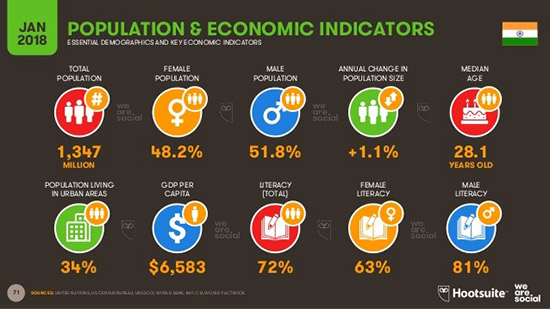
Source: https://www.slideshare.net/wearesocial/digital-in-2018-in-southern-asia-86866282
Industry annual projections and assessment affirm that mobile will be the primary device for internet access. Across the world, 2018 stats indicate that Asia Pacific region has registered the highest mobile data traffic. Games and entertainment precede all other forms of content with education coming up last.
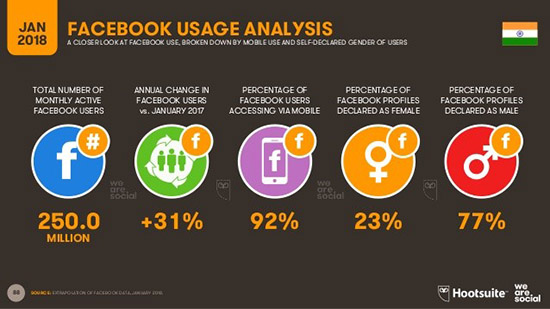
Source: https://www.slideshare.net/wearesocial/digital-in-2018-in-southern-asia-8686622
The Indian language online content is expected to reach about 60 percent. Therefore, digital destinations across genres will capitalise on the profile that is non-English. The question legacy media leaders are reflecting upon is whether they can convert their content into digital attractions or face the disruption by digital natives that is eroding the traditional player's role and position. This disruption may not be as fast and displacing as it is in the West but the writing on the wall is there.

Latest stats are available too but the above is from We Are social agency that releases worldwide and country specific statistics.
Information has been considered as an enabling and empowering input. The speed with which it currently travels through several platforms has raised erstwhile concerns about legacy media content through adaptation or user-generated content (UGC). Ethics apart, legacy media is reposed with higher faith based on its screening and verification process and layered institutional processing. While UGC reflects a paradigm shift with regard to the fact that theoretically allows for higher participation. The millennials profile is not uniform across countries and therefore the kind and nature of content have come into sharper focus. Critique of what kind of content is consumed or circulated is a matter of both academic discourse and the legal and regulatory frameworks.
The spectre of fake news with different connotations in other contexts stares us particularly in surcharged communal and electoral politics. The vulnerability is so high that the standard operating procedure in the recent past has been recourse to Internet shut down in volatile contexts. Fake news was also sought to be formally regulated and it was withdrawn as clarity was lacking as to where does such news originate. Several concerned professionals who have reflected on it suggest that among many platforms WhatsApp seems to be the most widely used.
“Fake news is a bit of a misleading term, believes Pankaj Jain, one of India’s most active fake news slayers: Fake news can mean many things – a mistake, intentional misleading, twisting a news story, or fabricating a complete lie. In the past while media houses and credible journalists have been found to put out misleading stories and/or mistakes, the most damage is done by people, fake social media profiles, polarising websites, and pages which spread fake news intentionally for garnering votes and spreading hate,” Jain says. Out of all the channels through which fake news spreads, Jain, whose initiative, Social Media Hoax Slayer, blows the lid off of false information being passed around social media platforms, feels the biggest culprit is the instant messaging app, WhatsApp.” (Sachadeva, 2018)
This has a comparative resonance in, for example, South East Asia.
Karen Lema and other analysing the scenario observe that “most worrying to media rights advocates is that several countries are promoting new legislation or expanding existing regulations to make publishing fake news an offense. The fear is that, rather than focusing on false stories published on social media, authoritarian leaders will use the new laws to target legitimate news outlets that are critical of them.” (Lema, 2018)
Reference in academic literature to user-generated content (UGC) is indicative of a reversal of the overwhelming argument that media in their broadest form is more of an information push or downloadable factor rather than the user having a say. Social media platforms with UGC are examples that have upheld the user. Promising as it may be, it has also revealed an inherent pattern of groupism, territorialization, and affiliations along homogenous sets of ideas and practices. In diverse and plural contexts, this has caused concerns of furthering social schisms.
Has entertainment gone beyond the cartels and expanded? Uploading of one's own form of entertainment is evident and nascent revenue and acceptance models can be worked out. A related but important aspect with regard to the Millennials is their familiarity and dexterous use of new media platforms. “Global total broadcast TV advertising revenue, consisting of multi-channel and terrestrial TV advertising revenues, accounted for 97.2% of global total TV advertising revenue in 2014. But as viewing continues to move away from traditional networks towards digital alternatives, advertisers will consider changing where they allocate their expenditure to reach desired demographic segments.” (PWC estimate)
While education in the formal sense is imbued with a host of debates of the public sector, commercialization, and privatization, a default faith is placed in the new media that can virtually bring "handheld” education to the millennials. This is an area public and private sector education sector intend to reach out through online education and learning options.
The extension models of higher education seem to suggest that this can be tapped to bring the skilled youth to the workforce. The transformative potential and better forms of content production and dissemination are immense. With telecoms in fierce competition and entertainment firms collaborating with them, the spread is vast. Do they contribute to the millennials forging ahead or is the latent disruption more than the potential build up to better contexts daunts us?
I am hopeful that the vast research and academic experience that each one of you brings to this conference helps us unravel the complexities and move forward.
Note
(1). The growth of print media for example is explained by many factors including literacy, low subscription and newsstand rates, hyper localisation etc. The millennial specific dimension has not been captured in industry-supported surveys as they say 12+ years and do not stratify the base by age.
